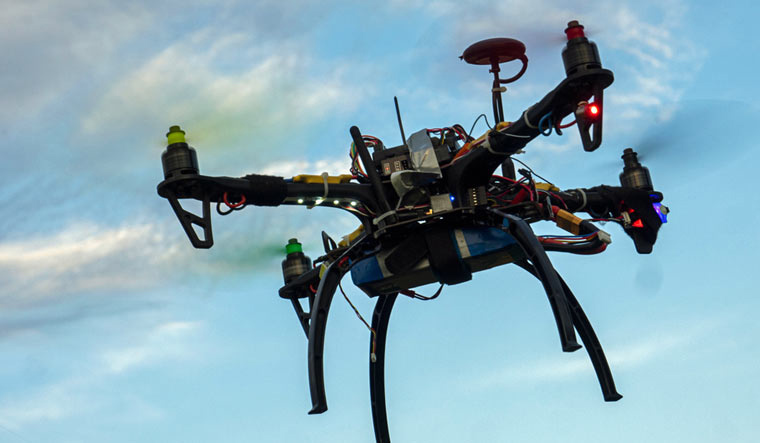The bomb disposal squad of the National Security Guard and a National Investigation Agency team are at the Indian Air Force station in Jammu where low-flying drones were used to drop two IEDs, in a first-of-its-kind attack on a defence establishment in the early hours on Sunday.
Initial reports said that two drones, used to drop two IEDs, were likely flown from across the international border with Pakistan but further investigation will ascertain the exact flight path and outfits behind it.
However, the Central intelligence agencies have reported increased drone activity by Pakistan in June, with at least three drone strikes being thwarted. One drone went back but arms were recovered by the border security forces.
“There must have been more attempts but three drone strikes were averted this month,” said a senior security official.
While the NIA has the mandate to investigate terror attacks, including airborne strikes, the elite NSG bomb squad will examine the IED usage to see the kind of explosives used to cause maximum damage.
The attack in Jammu has come close on the heels of the all-party meeting on Jammu and Kashmir called by the Centre, but intelligence sources said there are no direct links yet of whether the drone attack was planned as retaliation to destabilise the democratic process in the UT.
However, over the last several months, especially since 2019, there have been regular intelligence inputs on Pakistan sending drones that can either drop weapons or communication equipment that would help the ISI in picking up intelligence or tracking movement of Indian forces.
The Balakot airstrike by India had made the Pakistan Army even more wary of operations by Indian security forces.
The latest attempt is being seen as a desperate measure by the Pakistan Army, which has been unsuccessful in attempting to infiltrate terrorists across the International Border and Line of Control. Indian agencies have received inputs of Punjab and Jammu sectors being used to send drones. There is also a suspicion that Pakistan-based terror group Lashkar-e-Tayyaba had planned the attack as a retaliation to the bomb explosion near the residence in Lahore of LeT patron and JuD leader Hafiz Saeed.
Senior intelligence officials said Lashkar-e-Tayyaba has been training its cadres to use drone technology to carry out terror attacks.
“Earlier, such attempts were largely on the LoC, but given the changed situation post-withdrawal of Article 370, the international border is the new target of the Pak army and their drones,” said a security official.
Alarm bells went off in 2019 when a drone was sighted at the border near Ferozepur in Punjab. Then another drone was recovered and one was found in a burnt condition from Jhabal town in Tarn Taran. Punjab Chief Minister Amarinder Singh had blamed Pakistan for such incidents and asked the NIA to probe an incident where nearly 80kg of weapons were sent across the border. It was suspected at that time that Pakistan-based Khalistani terror groups were part of the sinister plot of the ISI to carry out strikes in Jammu and Kashmir.
Meanwhile, the latest incident has once again brought into focus the need for anti-drone technology. While the uniform drone policy of the Centre makes it mandatory to have a licence to fly a drone, it does not talk of an anti-drone mechanism.
With the bureau of civil aviation and security setting up a high-powered committee to facilitate the deployment of anti-drone facilities especially at high-risk airports, several trials, including by two Israeli companies, were held in the last two years to demonstrate their technology to incapacitate such drones sent by inimical forces into Indian territory. But it was not found effective.
Fresh trials are going on to try newer technologies to destroy drones entering Indian airspace.
Government sources said there is an urgent need to fast-track such efforts at air defence bases as well as civilian airports, to thwart any attacks.
There is still no clarity on which technology to use. The soft-kill technology means that any rogue drone that flies into secured airspace can be destabilised and its system will get frozen. The hard-kill technology means that the drone itself can be destroyed. The aim is to deploy hard-kill technology, which is more effective.
also read
- IAF commanders to discuss ‘Gagan Shakti’ lessons in apex four-day meet
- How induction of 56 C-295 military aircraft will make Indian Air Force more deadly and agile
- Andhra Pradesh showcases drone technology during recent floods as a success story
- IN PICS | Chennai IAF airshow: How bad was the crowd, traffic at Marina Beach as 5 dead, Velachery railway station crowded?
“There is a definite need to take the drone threat seriously,'' said a senior home ministry official. Intelligence officials said aerial threats require immediate attention as unmanned aerial vehicles or drones can quietly be used by terror outfits to violate the airspace for subversive activities or even cause potential collisions.
Besides drones, parachute droppings of men and arms and using unmanned aerial vehicles to violate airspace for possible collisions and subversive activities is something that cannot be ruled out in the near future, said an official.
The high-powered committee set up by the BCAS included members from the Airport Authority of India, National Security Guard and National Technical Research Organisation (NTRO) besides representatives of the Central Industrial Security Force and the ministries of home and civil aviation.





